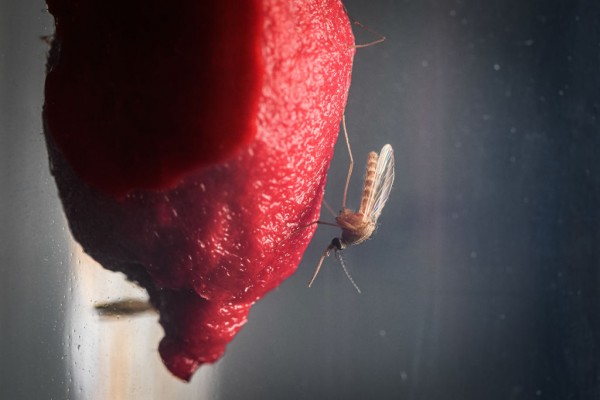Study Presents an Invasive Asian Mosquito Species That Threatens African Cities

An Asian tiger mosquito feeds on warm blood from a cotton pad in a laboratory of the Friedrich-Loeffler-Institute, where mosquitos are bred by scientists on December 02, 2019, in Greifswald, Germany.
An investigation revealed on Monday, a mosquito species that initially came from Asia and threatened to put millions of people in Africa at higher risk of developing malaria as described as "invasive insect" spread across the continent.
Malaria, the illness that claimed the lives of hundreds of thousands of people, mostly children in Africa, in 2018, is caused by parasites that around 40 species of mosquitoes spread among humans when they feed.
According to reports that came out recently, a group of mosquito species known as the "Anopheles gambiae" are said to be the main drivers of the spread of malaria in Africa. However, these insects do not like the polluted ponds saw in the cities, and have not learned how to have their larvae laid in "urban freshwater tanks." For these reasons, reports also indicated, most of the malaria in Africa takes place in rural areas.
ALSO READ: First 2 Deaths of 2020 Due To West Nile Virus Reported in Dallas County
The Spread of 'Anopheles Stephensi'
In new research, which the Proceedings on the National Academy of Sciences or PNAS recently published, Marianne Sinka, a medical entomologist at the University of Oxford, charted the spread of "Anopheles stephensi," another species which originated in Asia.
According to the study, the species has discovered how to slip through cracks to enter into water tanks preferring the ones made from cement and brick. Sinka said it is the only species "that are really good at getting into central urban areas."
This same species was the reason for the significant outbreak that took place in 2012 in Djibouti City in the Horn of Africa. In this city, there was a rare existence of malaria and has since been seen in Ethiopia, Sudan, and somewhere else.
In a report from the Centers for Diseases and Control Prevention, in 2012, "Routine public health tracking activities first discovered the Anopheles stephensi."
The said species, according to the CDC report, "Found its way from its native environment in Southern Asia to Eastern Africa."
Together with her colleagues, Sinka pooled location data for the "Anopheles stephensi" with spatial prototypes that determined the environmental circumstances that characterized its favored habitat, which, they said, "high-density urban areas" where the weather is hot, and it rains a lot.
DON'T MISS THIS: UK Might Roll Out Antibody Tests With at Least 98% Accuracy by the End of the Year
More than 40 African Locations Studied
The said research found that around 44 cities are "highly suitable" areas for insects, putting more than 120 million more Africans, primarily around equatorial locations that are at risk of malaria, compared to present.
Meaning, Africa, which has got the highest malaria burden already, could get an even more significant effect, explained Sinka, with 40 percent of the continent's population in urban places.
The study specified, different from the African mosquitoes, which like biting humans when it's cool at night, this species can feed in the evening when the climate is warmer, "making bed nets less effective."
Therefore, putting mosquito nets on windows, soaking the walls using insecticides, and having the body covered are among the effective ways to protect from this mosquito species.
In the long run, the study authors proposed, the measure that's considered most effective "is to target the larvae, remove stagnant water and seal water tanks tightly from intrusion. These approaches, Sinka said, have been proven effective in India.
IN CASE YOU MISSED THIS: Tricare Issues an Apology Statement After Telling 600k Beneficiaries They've Had COVID-19.
Check out more news and information on the Invasive Mosquitoes on MD News Daily.
Sep 15, 2020 08:40 AM EDT





